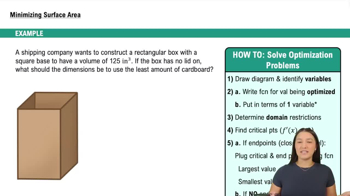A hemispherical bowl of radius 8 inches is filled to a depth of h inches, where 0≤h≤8 0 ≤ ℎ ≤ 8 . Find the volume of water in the bowl as a function of h. (Check the special cases h=0 and h=8.)
Table of contents
- 0. Functions7h 54m
- Introduction to Functions16m
- Piecewise Functions10m
- Properties of Functions9m
- Common Functions1h 8m
- Transformations5m
- Combining Functions27m
- Exponent rules32m
- Exponential Functions28m
- Logarithmic Functions24m
- Properties of Logarithms36m
- Exponential & Logarithmic Equations35m
- Introduction to Trigonometric Functions38m
- Graphs of Trigonometric Functions44m
- Trigonometric Identities47m
- Inverse Trigonometric Functions48m
- 1. Limits and Continuity2h 2m
- 2. Intro to Derivatives1h 33m
- 3. Techniques of Differentiation3h 18m
- 4. Applications of Derivatives2h 38m
- 5. Graphical Applications of Derivatives6h 2m
- 6. Derivatives of Inverse, Exponential, & Logarithmic Functions2h 37m
- 7. Antiderivatives & Indefinite Integrals1h 26m
- 8. Definite Integrals4h 44m
- 9. Graphical Applications of Integrals2h 27m
- 10. Physics Applications of Integrals 3h 16m
- 11. Integrals of Inverse, Exponential, & Logarithmic Functions2h 34m
- 12. Techniques of Integration7h 41m
- 13. Intro to Differential Equations2h 55m
- 14. Sequences & Series5h 36m
- 15. Power Series2h 19m
- 16. Parametric Equations & Polar Coordinates7h 58m
9. Graphical Applications of Integrals
Introduction to Volume & Disk Method
Problem 6.6.23b
Textbook Question
Determine whether the following statements are true and give an explanation or counterexample.
b. If f is not one-to-one on the interval [a, b], then the area of the surface generated when the graph of f on [a, b] is revolved about the x-axis is not defined.
 Verified step by step guidance
Verified step by step guidance1
Recall the definition of a one-to-one function: a function \( f \) is one-to-one on an interval \( [a, b] \) if for every \( x_1, x_2 \in [a, b] \), \( f(x_1) = f(x_2) \) implies \( x_1 = x_2 \). This means the function never takes the same value twice on that interval.
Understand the formula for the surface area generated by revolving the graph of \( f \) about the x-axis on \( [a, b] \). It is given by:
\[
S = \int_a^b 2\pi |f(x)| \sqrt{1 + (f'(x))^2} \, dx
\]
This formula requires \( f \) to be continuous and differentiable on \( [a, b] \), but it does not require \( f \) to be one-to-one.
Analyze the statement: "If \( f \) is not one-to-one on \( [a, b] \), then the surface area is not defined." Since the surface area formula depends on \( f(x) \) and \( f'(x) \), as long as these are well-defined and integrable, the surface area can be computed regardless of whether \( f \) is one-to-one.
Consider a counterexample: a function like \( f(x) = \sin x \) on \( [0, 2\pi] \) is not one-to-one, but it is continuous and differentiable. The surface area generated by revolving \( \sin x \) about the x-axis on this interval is well-defined and can be calculated using the formula.
Conclude that the statement is false because the one-to-one property is not necessary for the surface area to be defined. The key requirements are continuity and differentiability of \( f \) on \( [a, b] \).
 Verified video answer for a similar problem:
Verified video answer for a similar problem:This video solution was recommended by our tutors as helpful for the problem above
Video duration:
2mPlay a video:
Was this helpful?
Key Concepts
Here are the essential concepts you must grasp in order to answer the question correctly.
One-to-One Functions
A function is one-to-one (injective) if each output corresponds to exactly one input. This property ensures no repeated y-values for different x-values. Understanding whether a function is one-to-one helps analyze its behavior but is not always necessary for defining surface areas of revolution.
Recommended video:

One-Sided Limits
Surface Area of Revolution
The surface area generated by revolving a curve y = f(x) around the x-axis on [a, b] is calculated using the integral formula 2π ∫_a^b f(x)√(1 + (f'(x))^2) dx. This formula requires f to be continuous and differentiable, but not necessarily one-to-one.
Recommended video:

Example 1: Minimizing Surface Area
Conditions for Surface Area Integral to be Defined
For the surface area integral to be defined, the function must be continuous and have a well-defined derivative on [a, b]. The function need not be one-to-one; even if f repeats values, the integral can still be evaluated, so non-injectivity does not prevent defining the surface area.
Recommended video:

Example 1: Minimizing Surface Area

 5:38m
5:38mWatch next
Master Introduction to Cross Sections with a bite sized video explanation from Patrick
Start learningRelated Videos
Related Practice
Textbook Question
51
views
